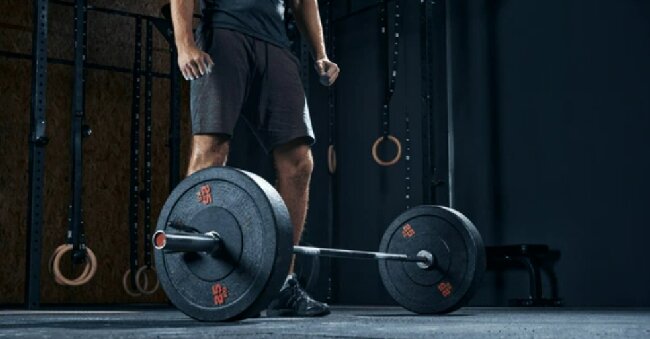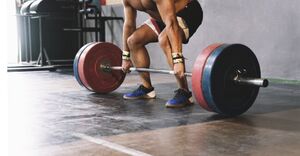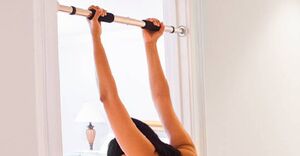
7 Powerful Reasons Olympic Barbells Outshine Standard Barbells | NutroOne
Are you looking to level up your weightlifting game but not sure which type of barbell is right for you?
In this detailed comparison, we will explore the differences between Olympic Barbells and Standard Barbells.
From dimensions and weight limits to design and construction, we will break down the key differences between the two types of barbells.
Whether you’re a seasoned lifter or just starting out, understanding these factors will help you make an informed decision on which barbell is best suited for your training goals.
What Are Barbells?
Barbells are essential gym equipment used for various strength training and weightlifting exercises. They consist of a long metal bar with weights attached at each end, allowing users to perform a wide range of exercises to build muscle and improve overall fitness.
These versatile tools are integral in developing muscle strength and endurance, making them a staple in any fitness routine. With different types such as Olympic barbells and standard barbells, individuals can target specific muscle groups and increase resistance for progressive overload. The significance of barbells lies in their ability to engage multiple muscles simultaneously, leading to functional strength gains and improved athletic performance.
Whether you’re a beginner or an experienced lifter, incorporating barbell exercises into your workout regimen can yield significant results in achieving your fitness goals.
What Are Olympic Barbells?
Olympic Barbells are specialized barbells designed for Olympic weightlifting exercises and competitions. They are known for their standard specifications and high-quality construction, making them ideal for powerlifting and Olympic lifts such as the clean and jerk and snatch.
These barbells are distinguishable by their rotating sleeves, which allow the weight plates to spin independently during lifts, reducing the risk of injury and enabling smoother and more efficient movements. The knurling pattern on Olympic Barbells provides a secure grip for lifters, enhancing control and stability during heavy lifts. Their durability and ability to withstand high-impact drops also make them a reliable choice for intense training sessions.
Olympic weightlifting has gained popularity for its dynamic and explosive movements, testing an athlete’s strength, speed, and coordination. Incorporating Olympic lifts into fitness routines can improve overall strength, power, and athleticism.
What Are the Dimensions of Olympic Barbells?
Olympic Barbells have standardized dimensions, including a length of 2200mm, a sleeve diameter of 50mm, and a weight of 20kg for men’s bars and 15kg for women’s bars. The sleeves of Olympic Barbells rotate to allow smooth movement during lifts.
This feature is crucial for weightlifters as it reduces the risk of wrist strain and promotes proper form. The rotating sleeves also enable quick plate changes, facilitating efficient training sessions. The 50mm sleeve diameter accommodates standard Olympic weight plates, ensuring compatibility across gym setups. The 2200mm length provides ample space for wide grip variations, aiding in exercises like snatches and clean and jerks. These dimensions play a key role in creating a balanced and stable barbell for athletes to maximize their lifting potential.
What Are the Weight Limits of Olympic Barbells?
Olympic Barbells are designed to handle heavy loads, with weight limits ranging from 300-1000 pounds depending on the bar’s quality and material.
The range of weight capacity that Olympic Barbells offer is crucial for individuals engaging in weightlifting and strength training. By incorporating Olympic plates, users can easily adjust the load to meet their specific workout requirements. This flexibility allows for progressive overload, a key principle in building strength and muscle.
Understanding the weight limits of barbells is essential in ensuring safety during lifts and maximizing training effectiveness. Whether aiming for personal fitness goals or professional athletic performance, having the right load capacity is fundamental for a successful training program.
What Are the Benefits of Using Olympic Barbells?
Using Olympic Barbells offers several advantages, including improved performance in weightlifting exercises, enhanced durability due to high-quality construction, and better grip provided by the knurling on the bar. These benefits contribute to efficient and safe training sessions.
The durability of Olympic Barbells ensures they can withstand heavy use and intense training regimens, making them a reliable investment for athletes and fitness enthusiasts. The enhanced grip from the knurling not only helps maintain proper hand placement during lifts but also minimizes the risk of the bar slipping, promoting better technique execution and reducing the chance of injuries. These characteristics not only impact weightlifting techniques positively but also aid in muscle development by allowing individuals to lift heavier weights with more control and stability, leading to improved strength gains and overall training effectiveness.
What Are Standard Barbells?
Standard Barbells are traditional weightlifting bars that come in various sizes and weights, suitable for general fitness and strength training. They are commonly used in home gyms and offer a cost-effective alternative to Olympic Barbells.
These bars are typically around 5 to 6 feet in length and can weigh anywhere from 15 to 50 pounds, making them ideal for a wide range of exercises such as curls, presses, and squats. Standard Barbells are often made of solid steel or iron, providing durability and stability during workouts. Their versatility allows users to target different muscle groups effectively, while their affordability makes them accessible to those who are setting up a home gym on a budget.
What Are the Dimensions of Standard Barbells?
Standard Barbells vary in dimensions, typically ranging from 5 to 7 feet in length, with sleeve diameters around 1 inch. The weight of Standard Barbells can vary based on the type of bar and the addition of collars to secure weight plates.
The size specifications play a crucial role in the versatility of Standard Barbells during strength training. For instance, a shorter barbell may be preferred for exercises like curls or shoulder presses, offering better control and focus on targeted muscles. On the other hand, longer barbells are ideal for exercises such as bench presses or squats, providing a wider grip and increased stability.
The collar usage is essential for securing weight plates in place, ensuring a safe and efficient workout session without the risk of plates sliding off during movements.
What Are the Weight Limits of Standard Barbells?
Standard Barbells have load capacities ranging from 100 to 300 pounds, depending on the bar’s quality and design. Users can adjust the weight by adding or removing weight plates, making them suitable for beginners and intermediate lifters.
This versatility in weight adjustment allows individuals to progressively challenge themselves as they improve their strength and endurance. By incrementally increasing the load, users can effectively track their fitness progress and set new goals to strive towards. The ability to customize the weight according to individual capabilities also ensures that each workout remains challenging and engaging.
Whether someone is just starting their fitness journey or looking to advance to heavier lifts, the flexibility of standard barbells and weight plates offers a scalable and adaptable solution for diverse training needs.
What Are the Benefits of Using Standard Barbells?
Standard Barbells offer benefits such as versatility in exercises, cost-effectiveness compared to Olympic Barbells, and quality construction for consistent performance. Their affordability makes them a popular choice for home gym setups.
This versatility allows users to perform a wide range of exercises, from basic lifts like squats and bench presses to more dynamic movements like rows and lunges, all using the same equipment.
The high-quality construction of Standard Barbells ensures durability even under intense workouts, providing users with long-lasting, reliable training tools.
The competitive pricing of these barbells makes them a cost-effective investment for individuals looking to build strength and improve fitness without breaking the bank.
How Do Olympic Barbells and Standard Barbells Differ?
Olympic Barbells and Standard Barbells differ in various aspects such as size, weight capacity, and construction quality. Olympic Barbells are tailored for specific weightlifting exercises and competitions, while Standard Barbells provide a more general approach to strength training.
- One significant difference between Olympic and Standard Barbells is the sleeve design. Olympic Barbells have rotating sleeves, which allow the weights to spin independently. This feature is beneficial for dynamic movements like cleans and snatches as it reduces strain on the wrists and elbows. On the other hand, Standard Barbells typically have fixed sleeves, which are more suitable for traditional exercises like bench press and squats.
The knurling patterns on Olympic Barbells are often more aggressive, providing a better grip during heavy lifts, while Standard Barbells may have a less prominent knurling for a comfortable hold when performing various exercises.
Size and Weight
One significant difference between Olympic Barbells and Standard Barbells is their size and weight specifications. Olympic Barbells are longer and heavier, with standardized dimensions for competitive weightlifting, while Standard Barbells come in various lengths and weights to cater to different training needs.
This standardization in Olympic Barbells ensures consistency in performance and allows athletes to train with precision.
On the other hand, the versatility of sizes and weights in Standard Barbells makes them ideal for a wide range of exercises, from basic strength training to more specialized workouts.
The adaptability of Standard Barbells enables users to customize their lifting experience according to their fitness goals, making them a popular choice among fitness enthusiasts and beginners alike.
Design and Construction
The design and construction of Olympic Barbells focus on high-quality materials, precision knurling for grip, and durable finishes to withstand rigorous weightlifting routines. In contrast, Standard Barbells may vary in material quality and finishes, offering a more budget-friendly option for general fitness enthusiasts.
Olympic Barbells are engineered with specific dimensions and weight specifications to meet the standards set by international weightlifting organizations, making them the preferred choice for professional athletes and serious lifters.
The knurling on Olympic Barbells is strategically patterned to provide an optimal grip during heavy lifts, aiding in stability and control.
The finishes on Olympic Barbells are often hard chrome or black oxide coatings, which not only enhance the barbell’s durability but also prevent rust and corrosion over time.
Cost
One of the key differences between Olympic Barbells and Standard Barbells is the cost factor. Olympic Barbells are generally more expensive due to their specialized design and high-end materials, while Standard Barbells offer a more budget-friendly option with similar benefits for fitness enthusiasts.
When considering the cost implications, it’s essential to weigh the upfront investment against the long-term value. While Olympic Barbells may come with a higher price tag initially, their durability and versatility often make them a worthwhile investment for serious weightlifters or fitness enthusiasts looking for top-notch equipment. On the other hand, Standard Barbells, despite being more affordable upfront, may require more frequent replacements or upgrades, potentially leading to a higher overall cost over time. It’s crucial to assess your fitness goals, budget, and commitment level before making a decision on which type of barbell to purchase.
Which One Should You Choose?
When deciding between Olympic Barbells and Standard Barbells, consider factors such as your training goals, budget, and specific preferences. Olympic Barbells are optimal for serious weightlifters and competitive athletes, while Standard Barbells cater to general fitness enthusiasts and home gym setups.
Olympic Barbells are designed to meet the rigorous demands of professional weightlifting and powerlifting competitions. They boast high-quality construction, precise weight specifications, and a standardized size for consistency in training.
On the other hand, Standard Barbells offer versatility and affordability, making them suitable for individuals looking to enhance their strength and fitness in a more casual setting.
Understanding the differences between these two types of barbells can help you make an informed choice aligned with your fitness journey and long-term training objectives.
Factors to Consider
When choosing between Olympic Barbells and Standard Barbells, consider factors such as your training frequency, muscle development goals, and lifting technique.
Olympic Barbells, commonly used in competitive weightlifting, are designed for heavy lifting and Olympic lifts like the snatch and clean and jerk. These barbells have a longer length and can hold more weight, making them ideal for strength training and muscle hypertrophy.
On the other hand, Standard Barbells are typically shorter and lighter, making them suitable for a wider range of exercises and beginners looking to improve overall fitness.
Proper lifting technique is crucial when using either type of barbell to prevent injury and maximize the effectiveness of your workout.
Personal Preference
Your personal preferences, such as grip comfort, sleeve rotation smoothness, and space availability in your home gym, can greatly influence the choice between Olympic Barbells and Standard Barbells. Consider factors like knurling, sleeve design, and overall barbell size before making a decision.
Ensuring that the barbell you choose complements your grip strength and comfort level can significantly impact your lifting performance and overall enjoyment during workouts. Sleeve rotation efficiency is essential for fluid movements and reducing strain on your wrists and forearms.
For home gym setups, the available space and storage options play a crucial role in the practicality of the barbell selection. Opting for a barbell with ergonomic features that align with your individual training needs can enhance your overall lifting experience and motivation to consistently engage in strength training.
Training Goals
Aligning your training goals with the specific benefits of Olympic Barbells or Standard Barbells is crucial for optimizing performance, ensuring safety during lifts, and refining lifting techniques. Evaluate whether you prioritize competitive weightlifting, overall fitness improvements, or muscle isolation exercises to make an informed decision.
If you are focused on enhancing your competitive weightlifting performance, Olympic Barbells are designed with specific features to meet the demands of professional lifting.
On the other hand, if your goal is overall fitness improvements or muscle isolation exercises, Standard Barbells provide versatility for various movements.
The choice between these two types of barbells also impacts your safety, as the grip and stability provided by Olympic Barbells differ from that of Standard Barbells, influencing your technique refinement and lifting efficiency.
External Source :https://nutroone.com/en/product/professional-olympic-curled-bar-1-2m-360kg-capacity/




No Comments